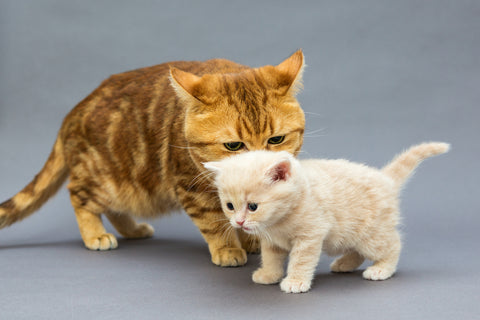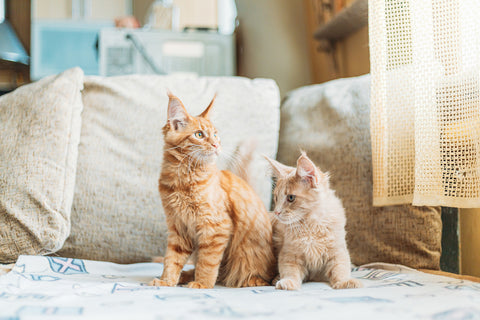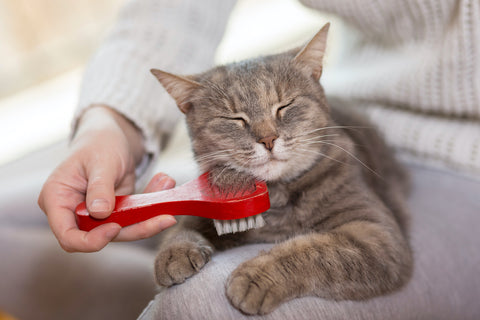Tiny Troublemakers: Can Cats Get Lice?
Cats are known for their pristine grooming habits, which often leave them looking sleek and elegant. However, no matter how meticulously they groom themselves, cats are not immune to parasites. While fleas and ticks are more commonly associated with feline infestations, another creepy-crawly critter can also plague our feline friends: lice.
In this article, we'll explore whether cats can indeed get lice, the signs of infestation, and how to prevent and treat it.
Can Cats Get Lice? Understanding the Feline Parasite Predicament
Can Cats Get Lice?
Yes, cats can get lice, but it's relatively rare. Unlike dogs, which can be infested with different types of lice, felines are primarily affected by Felicola subrostratus, a specific species of louse that specializes in infesting cats. These tiny insects are approximately 1-2 mm in size and are adapted to live on the skin and fur of cats, where they feed on their blood.

Signs of Lice Infestation in Cats
Excessive Scratching: One of the most common signs of lice infestation in cats is increased itching and scratching. Cats will scratch themselves to alleviate the discomfort caused by lice feeding on their blood and irritating their skin.
Hair Loss: Lice infestation can lead to hair loss, particularly in areas where the lice are most concentrated. You may notice patches of thinning fur, especially around the neck, shoulders, and ears.
Restlessness: Infested cats may become more agitated and restless. They may groom excessively in an attempt to remove the lice, which can worsen the infestation.
Dry, Flaky Skin: Lice bites can irritate a cat's skin, leading to dryness, flakiness, and redness. These skin changes can further contribute to discomfort and itching.
Visible Lice or Eggs: In severe cases, you may be able to spot lice or their eggs (nits) on your cat's fur. Lice are small, pale, and wingless insects that move slowly, while nits are tiny, oval-shaped structures attached to the hair shafts.
How Cats Contract Lice
Understanding how cats can contract lice can help you take preventive measures:
Contact with Infested Cats: The most common way cats get lice is through direct contact with an infected cat. This often happens during social interactions, such as grooming or playing.
Contaminated Environment: While less common, lice can survive for a brief period in the environment, such as on bedding, grooming tools, or furniture. Cats may become infested if they come into contact with these contaminated items.
Weakened Immune System: Cats with weakened immune systems are more susceptible to lice infestations. If your cat is ill, malnourished, or stressed, they may be at a higher risk.
Preventing Lice in Cats
Preventing lice in cats is essential to keep your feline companion healthy and comfortable. Here are some steps you can take:
Regular Grooming: Groom your cat regularly to check for signs of lice or other parasites. Brushing your cat's fur can also help remove loose hair and make it harder for lice to establish themselves.
Keep Cats Indoors: Limiting your cat's outdoor exposure can reduce the risk of encountering lice from other infested animals.
Quarantine New Cats: If you introduce a new cat into your home, consider quarantining them for a brief period to monitor for any signs of lice or other health issues.
Maintain a Clean Environment: Regularly clean your cat's bedding and living areas. Vacuuming can help remove any stray lice or eggs that may be present.

Treatment for Lice in Cats
Treating lice in cats often involves topical treatments or shampoos specifically designed to eliminate these parasites. It's crucial to follow your veterinarian's recommendations for the type of treatment and application method, as well as the duration of treatment.
In some cases, multiple treatments may be necessary to ensure all lice and their nymphs are eradicated. Your vet will also advise on how to properly dispose of any contaminated bedding or grooming tools to prevent re-infestation.
When to Seek Veterinary Care
If you notice any signs of lice infestation in your cat, such as excessive scratching, hair loss, or the presence of lice or nits, it's crucial to consult your veterinarian promptly. They can provide an accurate diagnosis, recommend an appropriate treatment plan, and offer guidance on preventing future infestations.
Importance of Regular Check-ups
Routine check-ups with your veterinarian are essential for your cat's overall health. During these visits, your vet can examine your cat's skin and coat for signs of parasites, including lice. Catching lice infestations early makes treatment more effective and lessens the risk of complications.
Beware of Over-the-Counter Products
While there are over-the-counter (OTC) treatments available for lice in cats, it's advisable to consult your veterinarian before using them. Not all OTC products are equally effective, and using the wrong one can potentially harm your cat or exacerbate the infestation.
Preventing Reinfestation
After successfully treating lice, it's essential to take steps to prevent re-infestation:
Quarantine: If you have multiple cats, consider temporarily separating the infested cat from the others during treatment to prevent the spread of lice.
Cleaning and Disinfecting: Thoroughly clean and disinfect your cat's living environment, including bedding, grooming tools, and any areas your cat frequents. Hot water washing and vacuuming are effective methods.
Regular Grooming: Continue with regular grooming to catch any potential reinfestations early.
Preventive Measures: Consult your veterinarian about preventive measures, such as topical treatments or medications, if your cat is at risk of re-infestation.
The Life Cycle of Cat Lice
Understanding the life cycle of cat lice can help you grasp the scope of the infestation and why it's essential to treat it promptly. Here's a brief overview of the life stages of cat lice:
Egg (Nit): Lice lay their eggs, or nits, close to the base of the hair shafts. Nits are tiny and oval-shaped and can be challenging to spot with the naked eye.
Nymphs: Nits hatch into nymphs. Nymphs are smaller than adult lice and undergo several molts before reaching maturity. During these stages, they feed on your cat's blood and cause irritation.
Adults: Once nymphs mature, they become adult lice. Adult lice are about 1-2 mm in size and are responsible for most of the itching and discomfort associated with infestations.
Reproduction: Adult female lice can lay hundreds of eggs during their lifespan, which can perpetuate the infestation if not treated.
Lice vs. Fleas and Ticks
Lice infestations in cats are often mistaken for other common external parasites like fleas and ticks. Here's a quick comparison to help you differentiate them:
Lice: Lice are wingless insects that typically remain on the cat's skin or fur, where they feed on blood. They move slowly and may be visible in severe infestations. Lice are species-specific, meaning they usually infest only one type of host (e.g., cats or humans).
Fleas: Fleas are small, agile insects that can jump and move quickly through your cat's fur. They bite to feed on blood and can cause itching, redness, and allergic reactions. Fleas are not species-specific and can infest cats, dogs, and even humans.
Ticks: Ticks are arachnids and are larger than both lice and fleas. They attach to the skin and feed on blood. Ticks can transmit diseases to cats and humans. Unlike lice, ticks are not as commonly mistaken for other parasites due to their distinct appearance.
Lice and Human Health
Feline lice are usually host-specific, meaning they prefer cats and don't readily infest humans. However, if you handle an infested cat or come into close contact with them, it's possible for lice to transfer temporarily. If you experience itching or discomfort after handling an infested cat, consult a healthcare professional.
In conclusion, while lice infestations in cats are relatively uncommon, they can occur, leading to discomfort and skin issues for your feline friend. Vigilance, regular vet visits, and proper treatment and prevention measures are key to keeping your cat lice-free and healthy. If you suspect your cat has lice or have concerns about their well-being, always consult with a veterinarian for guidance tailored to your specific situation.
Leave a comment
